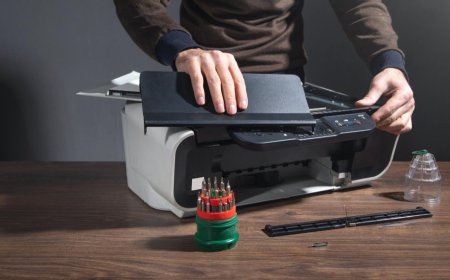CNC Turning Machines: The Backbone of Precision Manufacturing
Explore the capabilities, applications, and advantages of CNC turning machines. Learn how this precision technology drives modern manufacturing across industries.

Modern manufacturing thrives on efficiency, accuracy, and adaptability. Among the most relied-upon tools in todays industrial workshops is the cnc turning machine, which has become a vital component in producing high-precision cylindrical parts at scale. As automation and digitization continue to shape global production standards, CNC turning stands at the center of this transformation, enabling manufacturers to deliver consistent, complex components with minimal waste and downtime.
This article explores how CNC turning machines work, their major components, benefits, applications across industries, and key considerations for selecting the right equipment for your operation.
What Is a CNC Turning Machine?
A CNC turning machine is a type of automated lathe used to remove material from a rotating workpiece using a stationary cutting tool. Unlike traditional manual lathes, CNC turning machines are guided by pre-programmed software instructions, usually written in G-code, to achieve precise dimensions and repeatable results.
The core purpose of a CNC turning machine is to create cylindrical or round components. These machines are used in various manufacturing sectors to produce parts like shafts, bushings, pins, and threaded components. More advanced turning centers may also support secondary operations such as milling, drilling, or grooving, often using live tooling and multi-axis capabilities.
How It Works
The CNC turning process begins when a raw material bar is loaded into the spindle. The spindle rotates the workpiece while the cutting tool moves along predefined paths on the X and Z axes to shape the material. For more complex parts, additional axes such as Y and C may be involved, allowing for off-center milling and drilling.
Operations performed by CNC turning machines include:
-
Facing: Flattening the end of the part
-
Turning: Reducing the diameter by cutting along the outer surface
-
Threading: Creating internal or external threads
-
Boring and Drilling: Removing material from the interior
-
Parting or Cutting Off: Separating finished parts from the raw bar
Modern machines offer programmable speeds, feeds, and tool changes, providing operators with complete control over the production process.
Major Components of a CNC Turning Machine
1. Spindle
The spindle is the central rotating axis that holds the workpiece. It must deliver precise rotational speeds and torque depending on the material and operation.
2. Chuck
This is the clamping mechanism that secures the raw material. It may be a three-jaw chuck, collet chuck, or other type depending on the parts geometry and precision requirements.
3. Tool Turret
The turret holds various cutting tools and rotates to bring the correct tool into the cutting position. Some turrets support live tooling for combined milling and turning.
4. Guideways and Carriage
These allow the cutting tool to move smoothly along programmed paths. Precision guideways ensure stability and repeatability during the machining cycle.
5. CNC Controller
The brain of the system, the controller reads the G-code instructions and converts them into mechanical motion. It manages everything from spindle speed to tool change sequencing.
6. Coolant System
Coolants reduce friction, flush away chips, and keep the workpiece and tools at optimal temperatures, preventing deformation or excessive wear.
Benefits of CNC Turning Machines
1. Superior Precision
These machines can achieve micron-level tolerances, which is essential for applications in aerospace, automotive, and medical sectors.
2. Consistent Repeatability
Once a part is programmed and optimized, it can be produced repeatedly without variationperfect for large-scale production runs.
3. Reduced Labor and Setup Time
Thanks to automation, a single operator can manage multiple machines, reducing manual involvement and improving productivity.
4. High Material Versatility
CNC turning machines can process a wide range of materials, including stainless steel, aluminum, brass, titanium, and even plastics.
5. Integrated Features for Complex Parts
With live tooling and additional axis control, many turning centers can handle complex geometries in a single setup, reducing cycle times and improving overall efficiency.
Applications Across Industries
Aerospace
CNC turning machines are used to manufacture lightweight, high-precision components such as engine housings, fasteners, and flight-critical parts that must meet strict regulatory standards.
Automotive
From drive shafts and brake components to transmission gears and suspension parts, the automotive industry relies heavily on CNC turning for its scalability and precision.
Medical Devices
Implants, surgical tools, and diagnostic components must be manufactured with extreme accuracy and cleanliness. CNC turning ensures tight tolerances and smooth finishes for critical medical parts.
Oil and Gas
Turning machines are essential for machining threads, valves, couplings, and pipeline fittings made from tough materials that require both strength and precision.
General Engineering and Robotics
Applications in industrial automation and robotics often involve custom spacers, shafts, and housings that can be rapidly and reliably produced through CNC turning.
Factors to Consider When Choosing a CNC Turning Machine
1. Part Complexity
For simple round parts, a 2-axis machine may suffice. However, more complex components may require live tooling, sub-spindles, and multi-axis configurations.
2. Material Type
Machines should match the rigidity and spindle power required for the materials being processed. Heavier materials demand higher torque and stronger construction.
3. Volume Requirements
If you're producing parts in high volumes, look for automation-ready models with bar feeders, robotic loading systems, and chip conveyors.
4. Tolerance and Surface Finish Needs
Choose a machine capable of holding the specific tolerances and finish levels your industry requires. This often depends on machine build quality, spindle speed, and tooling.
5. Control System and Software Compatibility
Ensure the CNC controller supports your CAD/CAM workflow and offers user-friendly interfaces to reduce training time and errors.
Emerging Trends in CNC Turning
Smart Monitoring Systems
With the rise of Industry 4.0, modern machines are being equipped with sensors and real-time monitoring tools that provide performance feedback, predict maintenance needs, and help avoid costly downtime.
Hybrid Manufacturing
Some CNC turning centers now incorporate additive manufacturing features, allowing parts to be built up and finished in the same machine.
Energy Efficiency
Newer machines focus on reducing power consumption through intelligent motor control, improved coolant management, and idle power reduction.
Multi-Tasking Machines
The trend toward integrating multiple machining capabilities (e.g., turning + milling) into a single setup continues to grow, allowing more complex parts to be produced in less time.
Maintenance Tips for Longevity
Proper maintenance of CNC turning machines ensures performance consistency and extends service life:
-
Clean chips and debris daily
-
Lubricate guideways and moving parts weekly
-
Inspect tool wear and replace when needed
-
Monitor coolant levels and change filters regularly
-
Run periodic calibration tests
Preventive maintenance avoids unplanned downtime and reduces long-term repair costs.
Conclusion
The cnc turning machine has become an essential asset in high-precision manufacturing environments. Its ability to produce complex cylindrical parts quickly, consistently, and with minimal waste makes it ideal for a wide range of industries. Whether you're creating a single prototype or running a high-volume production line, CNC turning delivers the accuracy and scalability modern manufacturing demands.



























